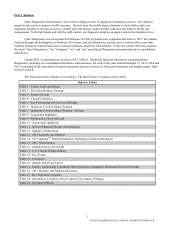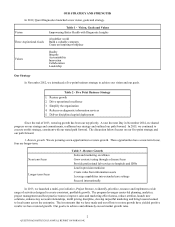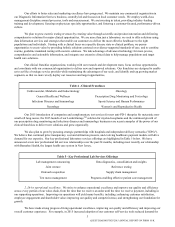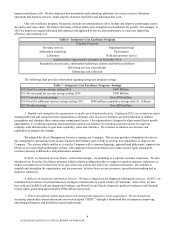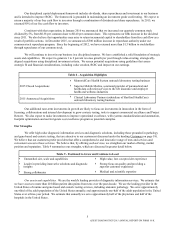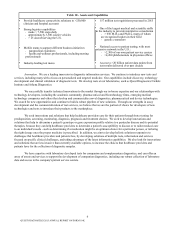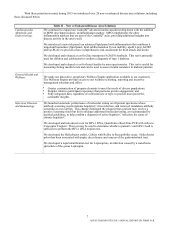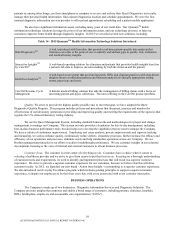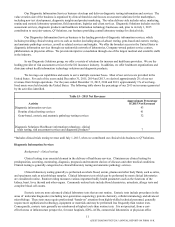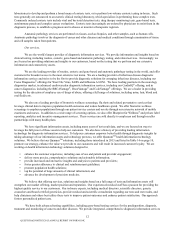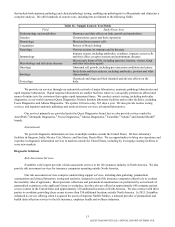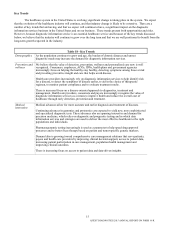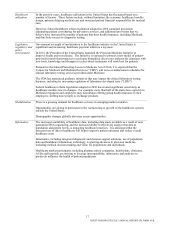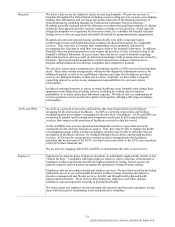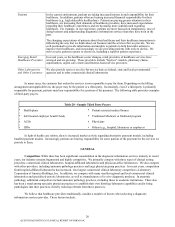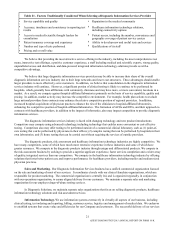Quest Diagnostics 2015 Annual Report Download - page 15
Download and view the complete annual report
Please find page 15 of the 2015 Quest Diagnostics annual report below. You can navigate through the pages in the report by either clicking on the pages listed below, or by using the keyword search tool below to find specific information within the annual report.
11
Our Diagnostic Information Services business develops and delivers diagnostic testing information and services. The
value creation side of the business is organized by clinical franchise and focuses on customer solutions for the marketplace,
including new test development, diagnostic insights and product marketing. The value delivery side includes sales, marketing,
routine and esoteric laboratory operations, field operations, logistics and client services. Diagnostic Solutions includes our risk
assessment services, diagnostic products and healthcare information technology businesses and, prior to its July 1, 2015
contribution to our joint venture, Q2 Solutions, our business providing central laboratory testing for clinical trials.
Our Diagnostics Information Services business is the leading provider of diagnostic information services, which
includes providing clinical testing services such as routine (including drugs-of-abuse) testing, gene-based and esoteric testing,
and anatomic pathology services, as well as related services and insights. We offer the broadest access in the United States to
diagnostic information services through our nationwide network of laboratories, Company-owned patient service centers,
phlebotomists in physician offices. We provide interpretive consultation through one of the largest medical and scientific staffs
in the industry.
In our Diagnostic Solutions group, we offer a variety of solutions for insurers and healthcare providers. We are the
leading provider of risk assessment services for the life insurance industry. In addition, we offer healthcare organizations and
clinicians robust health information technology solutions and diagnostic products.
We leverage our capabilities and assets to serve multiple customer bases. Most of our services are provided in the
United States. For each of the years ended December 31, 2015, 2014 and 2013, we derived approximately 2% of our net
revenues from foreign operations. For the years ended December 31, 2015, 2014 and 2013, approximately 1% of our long-
lived assets were held outside the United States. The following table shows the percentage of our 2015 net revenues generated
by the activities identified.
Table 15 - 2015 Net Revenues
Activity Approximate Percentage
of 2015 Net Revenues
Diagnostic information services 93
Routine clinical testing services 61
Gene-based, esoteric and anatomic pathology testing services 32
Diagnostic Solutions: Healthcare information technology, clinical
trials testing, risk assessment services and diagnostic products* 7
*Includes clinical trials testing revenue until July 1, 2015, when we contributed our clinical trials business to Q2 Solutions.
Diagnostic Information Services
Background - clinical testing.
Clinical testing is an essential element in the delivery of healthcare services. Clinicians use clinical testing for
predisposition, screening, monitoring, diagnosis, prognosis and treatment choices of diseases and other medical conditions.
Clinical testing is generally categorized as clinical laboratory testing and anatomic pathology services.
Clinical laboratory testing generally is performed on whole blood, serum, plasma and other body fluids, such as urine,
and specimens such as microbiology samples. Clinical laboratory tests which can be performed by most clinical laboratories
are considered routine. Routine testing measures various important bodily health parameters such as the functions of the
kidney, heart, liver, thyroid and other organs. Commonly ordered tests include blood chemistries, urinalysis, allergy tests and
complete blood cell counts.
Esoteric tests are more advanced clinical laboratory tests that are not routine. Esoteric tests include procedures in the
areas of molecular diagnostics (including next-generation sequencing), protein chemistry, cellular immunology and advanced
microbiology. These tests may require professional “hands-on” attention from highly-skilled technical personnel, generally
require more sophisticated technology, equipment or materials and may be performed less frequently than routine tests.
Consequently, esoteric tests generally are reimbursed at higher levels than routine tests. It is not practical, from a cost-
effectiveness or infrastructure perspective, for most hospitals, IDNs, ACOs, commercial laboratories or physician office
QUEST DIAGNOSTICS 2015 ANNUAL REPORT ON FORM 10-K


